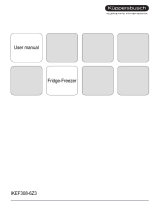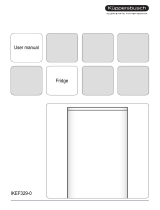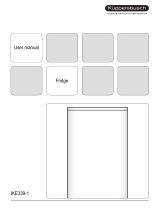
All other types of use are not permitted.
Foreseeable misuse
The following applications are expressly
forbidden:
-
Storing and refrigerating medicines, blood
plasma, laboratory preparations or similar
substances and products based on the
Medical Device Directive 2007/47/EC
-
Use in areas at risk of explosions
Misusing the appliance may lead to damage to
the goods stored or they may spoil.
Climate classifications
Depending on the climate classification the
appliance is designed to operate in restricted
ambient temperatures. The climate classifica-
tion applying to your appliance is printed on the
rating plate.
Note
u
Keep to the specified ambient temperatures
in order to guarantee that the appliance works
properly.
Climate classi-
fication
for ambient temperatures of
SN 10 °C to 32 °C
N 16 °C to 32 °C
ST 16 °C to 38 °C
T 16 °C to 43 °C
1.3 Conformity
The refrigerant circuit has been tested for leaks. In installed
condition, this appliance complies with the applicable safety
stipulations and with directives 2014/35/EU, 2014/30/EU,
2009/125/EG, 2011/65/EU and 2010/30/EU.
The BioFresh compartment satisfies the requirements for a
cold storage compartment in acc. with DIN EN 62552.
1.4 Product data
Product data is included with the appliance, as per Directive
(EU) 2017/1369. The complete product data sheet is available
on the Liebherr website under Downloads.
1.5 Saving energy
-
Pay attention to good ventilation. Do not cover ventilation
holes or grids.
-
Always keep the fan air slits clear.
-
Do not install the appliance in direct sunlight, next to an
oven, radiator or similar.
-
Energy consumption is dependent on the installation condi-
tions, e.g. ambient temperature (see 1.2) . If the ambient
temperature deviates from the standard temperature of
25°C, the energy consumption may differ.
-
Open the appliance for as short a time as possible.
-
The lower the temperature is set the higher the energy
consumption.
-
Arrange the food in an organised way (see 1) .
-
Keep all food properly packed and covered. This prevents
frost from forming.
-
Only take food out for as long as necessary so that it doesn’t
warm up too much.
-
Inserting warm food: allow to cool down to room temperature
first.
-
Thaw frozen food in the refrigerator.*
-
If there is a thick layer of frost in the appliance: defrost the
appliance.*
-
If you intend to be on holiday for a long time empty the refrig-
erator and switch it off.
2 General safety information
Danger for the user:
-
This device can be used by children and
people with impaired physical, sensory or
mental abilities or with a lack of experience
and knowledge provided that they are super-
vised or have received instruction in the safe
use of this device, and about the resulting
hazards. Children must not play with this
appliance. Cleaning and user maintenance
work must not be carried out by children
without adult supervision. Children aged
between 3 and 8 are allowed to load and
unload the appliance. Children below the age
of 3 must be kept away from the appliance
unless they are under continuous adult super-
vision.
-
When disconnecting the appliance from the
supply, always take hold of the plug. Do not
pull the cable.
-
In the event of a fault pull out the mains plug
or deactivate the fuse.
-
Do not damage the mains power cable. Do
not operate the appliance with a defective
mains power cable.
-
Repairs, interventions on the appliance and
the replacement of mains connection line may
only be carried out by After-Sales Service or
other suitably trained specialist personnel.
-
Only install, connect and dispose of the appli-
ance according to the instructions.
-
Only use the appliance when it is installed.
-
Please keep these instructions in a safe place
and pass them on to any subsequent owners.
-
Special lights, such as LED lights on the
appliance, are used to illuminate the interior
of the appliance and are not suitable for room
lighting.
Fire hazard:
-
Refrigerant R 600a is environmentally friendly,
but flammable. Leaking refrigerant may ignite.
•
Do not damage the refrigerant circuit pipes.
•
Do not use an open flame or other source
of ignition inside the appliance.
General safety information
* Depending on model and options 3

















